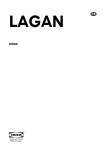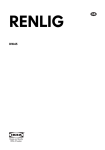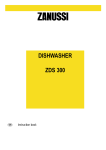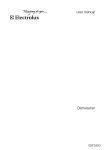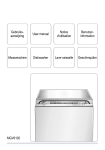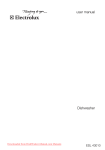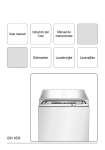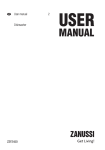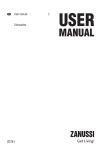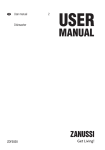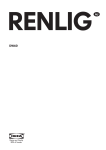Download IKEA DW60 User's Manual
Transcript
RENLIG DW60 GB ENGLISH 4 ENGLISH 4 Contents Safety information Product description Control panel Washing programmes Use of the appliance Setting the water softener Use of dishwasher salt Use of rinse aid Loading cutlery and dishes Use of detergent 4 6 7 9 10 10 11 12 12 14 Setting and starting a washing programme Care and cleaning What to do if… Technical data Installation Water connection Electrical connection Environment concerns IKEA GUARANTEE 15 16 17 19 19 20 21 21 21 Subject to change without notice Safety information For your safety and correct operation of the appliance, read this manual carefully before installation and use. Always keep these instructions with the appliance even if you move or sell it. Users must fully know the operation and safety features of the appliance. Correct use • The appliance is designed exclusively for domestic use. • Only use the appliance to clean household utensils that are applicable for dishwashers. • Do not put solvents in the appliance. Risk of explosion. • Put the knives and all items with sharp points in the cutlery basket with their points down. If not, put in a horizontal position in the upper basket. • Use only branded products for dishwashers (detergent, salt, rinse aid). • If you open the door while the appliance is in operation, hot steam can escape. Risk of skin burns. • Do not remove dishes from the dishwasher before the end of the washing programme. • When the washing programme is completed, disconnect the mains plug from the mains socket and close the water tap. • Only an authorised service engineer can repair this appliance. Use only original spare parts. • Do not do repairs yourself to prevent injury and damage to the appliance. Always contact your local After Sales Service. General safety • Persons (including children) with reduced physical sensory, mental capabilities or lack of experience and knowledge must not use the appliance. They must have supervision or instruction for the operation of the appliance by a person responsible for their safety. • Obey the safety instructions from the manufacturer of the dishwasher detergent to prevent burns to eyes, mouth and throat. • Do not drink the water from the dishwasher. Detergent residues can stay in your appliance. • Always close the door when you do not use the appliance to prevent injury and not to stumble over the open door. • Do not sit or stand on the open door. Child safety • Only adults can use this appliance. Children must get supervision to make sure that they do not play with the appliance. • Keep all the packaging away from children. There is a risk of suffocation. • Keep all detergents in a safe area. Do not let children touch the detergents. • Keep children away from the appliance when the door is open. ENGLISH Installation • Make sure that the appliance is not damaged because of transport. Do not connect a damaged appliance. If necessary, contact the supplier. • Remove all packaging before first use. • A qualified and competent person must do the electrical installation. • A qualified and competent person must do the plumbing installation. • Do not change the specifications or modify this product. Risk of injury and damage to the appliance. • Do not use the appliance: – if the mains cable or water hoses are damaged, – if the control panel, worktop or plinth area are damaged, that you can get access to the inner side of the appliance. If you have any doubts, please contact your After Sales Service. Refer to the list of the After Sales Services at the end of user manual. 5 • Do not drill into the sides of the appliance to prevent damage to hydraulic and electrical components. Warning! Carefully obey the instructions for electrical and water connections. ENGLISH 6 Product description 1 2 9 3 8 4 5 7 6 1 2 3 4 5 Upper basket Water hardness dial Salt container Detergent dispenser Rinse aid dispenser 6 7 8 9 Rating plate Filters Lower spray arm Upper spray arm ENGLISH 7 Control panel 5 1 2 A 1 2 3 4 5 4 3 B On/off button Half-load button Programme selection/cancel button (SELECT/CANCEL) Indicator lights Programme indicator lights Indicator lights The indicator light comes on when the washing programme is completed. Auxiliary functions: • Level of the water softener. • Activation/deactivation the audible signals. • An alarm if the appliance has a malfunction. 1) 1) The indicator light comes on when it is necessary to fill the rinse aid. Refer to the chapter 'Use of rinse aid'. The indicator light comes on when it is necessary to fill the salt container. Refer to the chapter 'Use of dishwasher salt'. The salt indicator light can stay on for some hours, but it does not have an unwanted effect on the operation of the appliance. 1) The indicator light is off while a washing programme operates. ENGLISH Programme selection/cancel button Use the programme selection/cancel button for these operations: • To set the washing programme. Refer to the chapter 'Setting and starting a washing programme'. • To set the water softener. Refer to the chapter 'Setting the water softener'. • To deactivate/activate the audible signals. Refer to the section 'Audible signals'. • To cancel a washing programme in progress. Refer to the chapter 'Setting and starting a washing programme'. Half-load button The half-load option is not available for all washing programmes. Refer to the chapter 'Washing programmes'. • Load dishes in the upper and lower basket. • Decrease the detergent dosage when you use the half-load option. • Press the half-load button to set the option. – The half-load indicator light comes on, when the half-load option is selectable. With the half-load button pressed the time duration and the consumption of water and energy are reduced. Setting mode The appliance is in setting mode when all the programme indicator lights are off and the end indicator light flashes. The appliance must be in setting mode for these operations: – To set a washing programme. – To set the water softener level. – To deactivate/activate the audible signals. If a programme indicator light is on, cancel the programme to go back to the setting mode. Refer to the chapter "Setting and starting a washing programme". Programme indicator lights A and B Apart the selection of the corresponding washing programme, these lights have an auxiliary functions: 8 • The adjustment of the water softener level. • Deactivation/activation of the audible signals. Audible signals You can hear an audible signal: • At the end of the washing programme. • When the appliance has a malfunction. The activation of the audible signals is set at the factory. Do these steps to deactivate the audible signals: 1. Switch on the appliance. 2. Make sure that the appliance is in setting mode. 3. Press and hold the programme selection/ cancel button until programme indicator light A flashes and programme indicator light B comes on. 4. Press the programme selection/cancel button again. – Programme indicator light A comes on. – Programme indicator light B starts to flash. 5. Wait until programme indicator light A goes off. – Programme indicator light B continues to flash. – The end indicator light comes on. The audible signals are activated. 6. Press the programme selection/cancel button again. – The end indicator light goes off. The audible signals are deactivated. 7. Switch off the appliance to save the operation. Do these steps to activate the audible signals: 1. Do the above procedure until the end indicator light comes on. ENGLISH 9 Washing programmes Washing programmes Programme Intensive Normal 1) Quick Eco 2) Hold Rinse & Degree of Type of load soil Programme description Half-load option Prewash Main wash up to 70°C 2 intermediate rinses Final rinse Drying yes Heavy soil Crockery, cutlery, pots and pans Prewash Main wash up to 65°C 2 intermediate rinses Final rinse Drying yes Normal soil Crockery, cutlery, pots and pans Normal or light soil Crockery and cutlery Main wash up to 60°C Final rinse no Normal soil Prewash Main wash up to 50°C 1 intermediate rinse Final rinse Drying yes Crockery and cutlery Any Partial load (to be completed later in the day) 1 cold rinse (to prevent food scraps to bond). Detergent is not necessary with this programme. no 1) This is the perfect daily programme to clean a not fully load. Ideal for a family of 4 persons who only want to load breakfast and dinner crockery and cutlery. 2) Test programme for test institutes. This is the economy washing programme. Please refer to separate leaflet supplied, for test data. Available only in 3 languages (English, French, German) just for test institutes purpose. Consumption values (for full washing cycle) Programme 1) Programme duration Energy consumption Water consumption (minutes) (kWh) (litres) 120-130 1,8-2,0 22-24 105-115 1,5-1,7 23-25 30 0,9 9 130-140 1,0-1,2 14-16 ENGLISH 10 Programme Programme duration Energy consumption Water consumption (minutes) (kWh) (litres) 12 0,1 5 1) The duration of this washing programme is prefixed (longer) than the others due to a prolonged drying and washing phases. The pressure and temperature of the water, the variations of power supply and the quantity of dishes can change these values. Use of the appliance Refer to the following instructions for each step of procedure: 1. Make a check if the water softener level is correct for the water hardness in your area. If necessary set the water softener. 2. Fill the salt container with dishwasher salt. 3. Fill the rinse aid dispenser with rinse aid. 4. Load cutlery and dishes into the dishwasher. 5. Set the correct washing programme for the type of load and soil. 6. Fill the detergent dispenser with the correct quantity of detergent. 7. Start the washing programme. If you use detergent tablets, refer to the chapter 'Use of detergent'. Setting the water softener The water softener removes minerals and salts from the water supply. Minerals and salts can have bad effect on the operation of the appliance. Water hardness is measured in equivalent scales: • German degrees (dH°). • French degrees (°TH). • mmol/l (millimol per litre - international unit for the hardness of water). • Clarke. Adjust the water softener to the water hardness in your area. If necessary, contact your local water authority. Water hardness Water hardness setting °dH °TH mmol/l Clarke manually electronically 51 - 70 91 - 125 9,1 - 12,5 64 - 88 2 10 43 - 50 76 - 90 7,6 - 9,0 53 - 63 2 9 37 - 42 65 - 75 6,5 - 7,5 46 - 52 2 8 29 - 36 51 - 64 5,1 - 6,4 36 - 45 2 7 23 - 28 40 - 50 4,0 - 5,0 28 - 35 2 6 19 - 22 33 - 39 3,3 - 3,9 23 - 27 2 5 15 - 18 26 - 32 2,6 - 3,2 18 - 22 1 4 11 - 14 19 - 25 1,9 - 2,5 13 - 17 1 3 ENGLISH 11 Water hardness Water hardness setting °dH °TH mmol/l Clarke manually electronically 4 - 10 7 - 18 0,7 - 1,8 5 - 12 1 2 <4 <7 < 0,7 <5 11) 11) 1) No use of salt required. You must set the water softener manually and electronically. Manual adjustment The appliance is set at the factory at position 2. 1 2 Set switch to position 1 or 2. Electronic adjustment The water softener is set at the factory at level 5. 1. Switch on the appliance. 2. Make sure that the appliance is in setting mode. 3. Press and hold the programme selection/ cancel button. 4. Release the programme selection/cancel button when programme indicator light A starts to flash and programme indicator light B comes on. 5. Wait until programme indicator light B goes off. – Programme indicator light A starts to flash. – The end indicator light starts to flash. 6. Press the programme selection/cancel button one time. – Programme indicator light A starts to flash. – The setting function of the water softener is activated. – The end indicator light flashes to show the level of the water softener. Example: 5 flashes, pause, 5 flashes, pause, etc... = level 5. 7. Press the programme selection/cancel button one time to increase the water softener level by one step. 8. Press the on/off button to save the operation. Use of dishwasher salt Caution! Only use dishwashers salt. Types of salt that are not applicable for dishwashers cause damage to the water softener. 1 2 ENGLISH 12 3 4 5 6 Fill the salt container with 1 litre of water (only the first operation). Fill the salt container with 1,5-2,0 kg of salt. Use the salt funnel supplied. Make sure that there is no grain of salt outer of the salt compartment. It is normal that water overflows from the salt container when you fill it with salt. Use of rinse aid Caution! Only use branded rinse aid for dishwashers. Do these steps to fill the rinse aid dispenser: 1 2 Caution! Do not fill the rinse aid dispenser with other products (e.g. dishwasher cleaning agent, liquid detergent). There is a risk of damage to the appliance. Adjusting the dosage of rinse aid The rinse aid dial is set at the factory at position 3. To increase or decrease the dosage refer to 'What to do if...' 3 4 M + AX - Loading cutlery and dishes Helpful hints and tips Caution! Only use the appliance for household utensils that are applicable for dishwashers. ENGLISH Do not use the appliance to clean objects that can absorb water (sponges, household cloths, etc.). • Before you load cutlery and dishes, do these steps: – Remove all food remainings and debris. – Make burnt, remaining food in pans soft. • While you load cutlery and dishes, do these steps: – Load hollow items (e.g. cups, glasses and pans) with the opening down. – Make sure that water does not collect in the container or in a deep base. – Make sure that cutlery and dishes do not lie inside one another. – Make sure that cutlery and dishes do not cover other cutlery and dishes. – Make sure that glasses do not touch other glasses. – Put small objects in the cutlery basket. • Plastic items and pans with non-stick coatings can keep water droplets. Plastic items do not dry as well as porcelain and steel items. • Put light items in the upper basket. Make sure that the items do not move. Caution! Make sure that the spray arms can move freely before you start a washing programme. Warning! Always close the door after you load or unload the appliance. An open door can be dangerous. 13 Use the cutlery grid. If the dimensions of the cutlery prevent use of the cutlery grid, remove it. Arrange the items to let water touch all surfaces (left). For longer items fold the cup racks up (right). Put plates in the rear part of the upper basket. Tilt them forward. Adjustment of the height of the upper basket If you put large plates in the lower basket, first move the upper basket to a upper position. Warning! Adjust the height before you load the upper basket. Arrange service dishes and large lids around the edge of the lower basket. Maximum height of the dishes in : • Upper basket. – Upper position: 20 cm. – Lower position: 24 cm. • Lower basket. – Upper position: 31 cm. – Lower position: 27 cm. ENGLISH 14 A A Do these steps to move the upper basket to the upper or lower position: 1. Move the front runner stops (A) out. 2. Pull the basket out. 3. Put the basket in the upper or lower position. 4. Replace the front runner stops (A) in their initial position. Caution! If the basket is in the upper position, do not put cups on the cup racks. Use of detergent Only use detergents (powder, liquid or tablet) that are applicable for dishwash- 4 3 ers. Follow the data on the packaging: • Dosage recommended by the manufacturer. • Storage recommendations. B A Do not use more than the correct quantity of detergent to save an environment. 1 2 Fill the detergent dis- If you use a washing penser (A) with de- programme with tergent. prewash phase, put more detergent in the prewash detergent compartment (B). 5 6 A Use of detergent tablets Put the detergent tablet in the detergent dispenser (A). Detergent tablets contain: • detergent • rinse aid • other cleaning agents. Do these steps to use detergent tablets: ENGLISH 15 1. Make sure that the detergent tablets are applicable for your water hardness. Refer to the instructions from the manufacturer. 2. Set the lowest levels of water hardness and rinse aid dosage. 2. Set the water softener to the highest level. 3. Do a washing programme without dishes. 4. Adjust the water softener. Refer to the chapter 'Setting the water softener'. 5. Adjust the rinse aid dosage. It is not necessary to fill the salt container and the rinse aid dispenser. Different brands of detergent dissolve in different times. Some detergent tablets do not have the best cleaning results during short washing programmes. Use long washing programmes when you use detergent tablets to fully remove the detergent. Do these steps when the drying results are not satisfactory: 1. Fill the rinse aid dispenser with rinse aid. 2. Set the rinse aid dosage to position 2. Do these steps to use the detergent powder again: 1. Fill the salt container and the rinse aid dispenser. Setting and starting a washing programme Set the washing programme with the door ajar. The washing programme only starts after you close the door. Until then it is possible to modify the settings. Do these steps to set and start a washing programme: 1. Switch on the appliance. 2. Make sure that the appliance is in setting mode. 3. Press the programme selection/cancel button again and again to set the washing programme. Refer to the chapter 'Washing programmes'. – The programme indicator light comes on. 4. Close the door. – The washing programme starts automatically. When the washing programme operates, you cannot change the programme. Cancel the washing programme. Warning! Only interrupt or cancel a washing programme if necessary. Caution! Open the door carefully. Hot steam can come free. Cancelling a washing programme 1. Press and hold the programme selection/ cancel button for approximately 3 seconds. – The programme indicator light goes off. – The end indicator light starts to flash. 2. Release the programme selection/cancel button to cancel the washing programme. At this time you can do these steps: 1. Switch off the appliance. 2. Set a new washing programme. Fill the detergent dispenser with detergent before you set a new washing programme. Interrupting a washing programme Open the door. • The programme stops. Close the door. • The programme continues from the point of interruption. End of the washing programme Switch off the appliance in these conditions: • The appliance stops automatically. • The audible signals for the end of the programme operate. 1. Open the door. – The end indicator light comes on. – The programme indicator light stays on. 2. Press the on/off button. ENGLISH 16 3. For better drying results, keep the door ajar for some minutes before you remove the dishes. Let the dishes cool down before you remove them from the appliance. Hot dishes are easily damaged. • There can be water on the sides and door of the appliance. Stainless steel becomes cool more quickly than the dishes. Removing the load • First remove items from the lower basket, then from the upper basket. Care and cleaning Warning! Switch the appliance off before you clean the filters. 6 5 Cleaning the filters Important! Do not use the appliance without the filters. Make sure that the installation of the filters is correct. Incorrect installation will cause unsatisfactory washing results and damage to the appliance. 1 2 B A 2 Put the filter system in position. To lock the filter system, turn the handle clockwise until it locks in position. Important! Do not remove the spray arms. A Fully clean the filters A, B and C below running water. 4 2 1 1 Put the flat filter A in the bottom of the appliance. Install the flat filter correctly under the two guides D. C 3 D A To remove filters B Remove the flat filter and C, turn the han- A from the bottom of dle approximately the appliance. 1/4 anticlockwise. If the holes in the spray arms become clogged, remove remaining parts of soil with a cocktail stick. Long periods of non-operation Do these steps when you do not use the appliance for a long period: 1. Disconnect the mains plug from the mains socket. 2. Close the water tap. 3. Keep the door open to prevent unpleasant smells. 4. Keep the inner side of the appliance clean (filters especially). External cleaning Clean the external surfaces of the appliance and control panel with a damp soft cloth. Only use neutral detergents. Do not use abrasive products, scouring pads or solvents (acetone, trichloroethylene etc...). ENGLISH 17 Frost precautions Caution! Do not install the appliance where the temperature is below 0 °C. The manufacturer is not responsible for damage because of frost. If not possible, empty the appliance and close the door. Disconnect the water inlet hose and remove water from the water inlet hose. What to do if… The appliance does not start or stops during operation. If there is a fault, first try to find a solution to the problem yourself. If you cannot find a solution to the problem yourself, contact your dealer or the After Sales Service. Problem Possible cause Solution • Continuous flash of the light of the running programme. • Intermittent audible signal. • 1 flash of the end indicator light. Malfunction: The dishwasher does not fill with water. The water tap is blocked or furred Clean the water tap. with limescale. • Continuous flash of the light of the running programme. • Intermittent audible signal. • 2 flashes of the end indicator light. Malfunction: The dishwasher will not drain. There is a blockage in the sink spi- Clean the sink spigot. got. The water tap is closed. Open the water tap. The filter in the water inlet hose is Clean the filter. blocked. The connection of the water inlet Make sure that the connection is hose is not correct. The hose can be correct. kinked or squashed. The connection of the water drain Make sure that the connection is hose is not correct. The hose can be correct. kinked or squashed. ENGLISH Problem 18 Possible cause Solution • Continuous flash Close the water tap and Contact your local After Sales Service. of the light of the running programme. • Intermittent audible signal. • 3 flashes of the end indicator light. Malfunction: The anti-flood device operates. Malfunction: The appliance door is not closed. Close the door. The programme Mains plug is not connected in. Put in the mains. does not start. The fuse has blown out in the Replace the fuse. household fuse box. After the check, switch on the appliance. The programme continues from the point of interruption. If the malfunction shows again, contact your After Sales Service. When the cleaning results are not satisfactory: Problem The dishes are not clean Possible cause Solution The selected washing programme is Set different washing programme. not applicable for the type of load and soil. The baskets are loaded incorrectly so Load the baskets correctly. that water cannot reach all surfaces. Spray arms do not turn freely because Make sure that the cutlery and dishes of incorrect arrangement of the load. do not block the spray arms. The filters are dirty or not correctly in- Make sure that the filters are clean stalled. and installed correctly. The quantity of detergent is too little Make sure that the quantity of deteror missing. gent in detergent dispenser is correct. Limescales The salt container is empty. Fill the salt container with salt. particles on the The water softener is adjusted on a Set the water softener. dishes wrong level. The salt container cap is not closed Make sure that the salt container is correctly. closed correctly. The dishes are wet and dull No rinse aid has been used. Set the rinse aid dosage. The rinse aid dispenser is empty. Fill the rinse aid dispenser. ENGLISH 19 Problem Possible cause There are streaks, milky spots or a bluish coating on glasses and dishes Solution Wrong dosage of rinse aid. Decrease the rinse aid dosage. Dry water drop Wrong dosage of rinse aid. signs on The detergent can be the cause. glasses and dishes Increase rinse aid dosage. Use different type of detergent. Technical data Dimensions Width (cm) 59,6 Height (cm) 81,8-87,8 Depth (cm) Water supply pressure1) Minimum Maximum Capacity (place settings) 12 Energy class A Washing class A Drying class A Noise (dB(A)) 49 Average annual energy consumption (kWh) 2) 231 Average annual water consumption (litres)2) 3520 55,5 0,5 bar (0,05 MPa) 8 bar (0,8 MPa) 1) If the pressure in your area is lower or higher, please contact your After Sales Service. 2) The data is based on the washing programme for test institutes assuming 220 cycles per a year. Information on the electrical connection, voltage and overall power is given on the rating plate on the inner edge of the dishwasher door. Installation Caution! Refer to the assembly instructions, in order to proceed with the installation. Warning! Make sure that mains plug is disconnected from the mains socket during installation. Place the appliance on the floor and install it under a counter (kitchen worktop or sink). ENGLISH If a repair is necessary, the appliance must be easily accessible for the engineer. Put the appliance adjacent to a water tap and a drain. 20 For the venting of the dishwasher only water fill, water drain and power supply cable openings are necessary. Water connection This appliance has a special inlet hose for water stop later defined as aqualock. Water inlet hose Connected the appliance to a hot (max. 60°) or cold water supply. If the hot water comes from alternative sources of energy that are more environmentally friendly (e.g. solar or photovoltaic panels and aeolian), use a hot water supply to decrease energy consumption. Connect the inlet hose to a water tap with an external thread of 3/4". Caution! Do not use connection hoses from an old appliance. Caution! If you connect the appliance to new pipes or pipes that are not used for a long time, we recommend to run the water for some minutes before you connect the inlet hose. Aqualock inlet hose The inlet hose is a high pressure resistant. It can hold pressure at maximum 6 MPa. From external the inlet hose has a sheathing against eventual damages. If the inner hose breaks, the water that is in the hose will became dark. You can see it across the special transparent sheathing. Turn off the water tap immediately and contact the After Sales Service. A B The aqualock inlet hose is installed with a safety device to prevent accidental loosening. To disconnect the hose: • Press the lever ( B ). • Turn the retaining ring ( A ) anticlockwise. Turn the inlet hose to the left or the right to suit the installation. Tight the locknut correctly to prevent water leaks. If you use a inlet hose extension the total reached length must be no longer than 4 metres. Drain hose A If you connect the water drain hose to a water trap under the sink, remove the plastic membrane (A). If you do not remove the membrane, remaining food can cause a blockage in the drain hose spigot. Caution! Make sure that the water couplings are tight to prevent water leakage. ENGLISH 21 Electrical connection Warning! The manufacturer is not responsible if you do not follow these safety precautions. Ground the appliance according to safety precautions. Make sure that the rated voltage and type of power on the rating plate agree with the voltage and the power of the local power supply. Always use a correctly installed shockproof socket. Do not use multi-way plugs, connectors and extension cables. There is a risk of fire. Do not replace the mains cable yourself. Contact the After Sales Service. Make sure that the mains plug is accessible after installation. Do not pull the mains cable to disconnect the appliance. Always pull the mains plug. Warning! The appliance is supplied with a 13 amp plug attached. Use a 13 amp ASTA approved (BS 1362) fuse if it is necessary to change the fuse in the plug supplied. A cut off plug inserted into a 13 amp socket is a serious safety danger. Make sure that it is disposed of safely. This appliance complies with the E.E.C. Directives. Environment concerns The symbol on the product or on its packaging indicates that this product may not be treated as household waste. Instead it should be taken to the appropriate collection point for the recycling of electrical and electronic equipment. By ensuring this product is disposed of correctly, you will help prevent potential negative consequences for the environment and human health, which could otherwise be caused by inappropriate waste handling of this product. For more detailed information about recycling of this product, please contact your local council, your household waste disposal service or the shop where you purchased the product. Before disposal of appliance Warning! Do these steps to dispose the appliance: • Pull the mains plug out of the mains socket. • Cut off the mains cable and discard it. • Discard the door catch. This prevents the children to close themselves inside the appliance. Risk of suffocation. Packaging materials The materials with the symbol are recyclable. Dispose the packaging in a suitable collection containers to recycle it. IKEA GUARANTEE How long is the IKEA guarantee valid? This guarantee is valid for five (5) years from the original date of purchase of Your appliance at IKEA, unless the appliance is named LAGAN in which case two (2) years of guarantee apply. The original sales receipt is re- ENGLISH quired as proof of purchase. If service work is carried out under guarantee, this will not extend the guarantee period for the appliance, Which appliances are not covered by the IKEA five (5) years guarantee? The range of appliances named LAGAN and all appliances purchased in IKEA before 1st of August 2007. Who will execute the service? IKEA service provider will provide the service through its own service operations or authorized service partner network. What does this guarantee cover? The guarantee covers faults of the appliance, which have been caused by faulty construction or material faults from the date of purchase from IKEA. This guarantee applies to domestic use only. The exceptions are specified under the headline “What is not covered under this guarantee?” Within the guarantee period, the costs to remedy the fault e.g. repairs, parts, labour and travel will be covered, provided that the appliance is accessible for repair without special expenditure. On these conditions the EU guidelines (Nr. 99/44/EG) and the respective local regulations are applicable. Replaced parts become the property of IKEA. What will IKEA do to correct the problem? IKEA appointed service provider will examine the product and decide, at its sole discretion, if it is covered under this guarantee. If considered covered, IKEA service provider or its authorized service partner through its own service operations, will then, at its sole discretion, either repair the defective product or replace it with the same or a comparable product. What is not covered under this guarantee? • Normal wear and tear. • Deliberate or negligent damage, damage caused by failure to observe operating instructions, incorrect installation or by connection to the wrong voltage, damage caused by chemical or electro-chemical reaction, rust, corrosion or water damage including but not limited to damage caused by excessive lime in the water supply, damage caused by abnormal environmental conditions. • Consumable parts including batteries and lamps. 22 • Non-functional and decorative parts which do not affect normal use of the appliance, including any scratches and possible color differences. • Accidental damage caused by foreign objects or substances and cleaning or unblocking of filters, drainage systems or soap drawers. • Damage to the following parts: ceramic glass, accessories, crockery and cutlery baskets, feed and drainage pipes, seals, lamps and lamp covers, screens, knobs, casings and parts of casings. Unless such damages can be proved to have been caused by production faults. • Cases where no fault could be found during a technician’s visit. • Repairs not carried out by our appointed service providers and/or an authorized service contractual partner or where nonoriginal parts have been used. • Repairs caused by installation which is faulty or not according to specification. • The use of the appliance in a non-domestic environment i.e. professional use. • Transportation damages. • Cost for carrying out the initial installation of the IKEA appliance, unless it is due to a repair or a replacement for faulty parts. This restriction does not apply to fault-free work carried out by a qualified specialist using our original parts in order to adapt the appliance to the technical safety specifications of another EU country. How country law applies The IKEA guarantee gives You specific legal rights, which covers or exceed local demands. However these conditions do not limit in any way consumer rights described in the local legislation Area of validity For appliances which are purchased in one EU country and taken to another EU country, the services will be provided in the framework of the guarantee conditions normal in the new country. An obligation to carry out services in the framework of the guarantee exists only if the appliance complies and is installed in accordance with: ENGLISH • the technical specifications of the country in which the guarantee claim is made; • the Assembly Instructions and User Manual Safety Information; The dedicated SERVICE for IKEA appliances Please do not hesitate to contact IKEA appointed SERVICE to: • make a service request under this guarantee; • ask for clarification on installation of the IKEA appliance in the dedicated IKEA kitchen furniture. The service won’t provide clarifications related to: – the overall IKEA kitchen installation; – connections to electricity (if machine comes without plug and cable), to water and to gas since they have to be executed by an authorized service engineer. • ask for clarification on user manual contents and specifications of the IKEA appliance. To ensure that we provide you with the best assistance, please read carefully the Assembly Instructions and/or the User Manual section of this booklet before contacting us. How to reach us if You need our service Please refer to the last page of this manual for the full list of IKEA appointed Service Providers and relative national phone numbers. Important! In order to provide You with a quicker service, we recommend that You use the specific phone numbers listed at the end of this manual. Always refer to the numbers listed in the booklet of the specific appliance You need an assistance for. Before calling us, assure that You have to hand the IKEA article number (8 digit code) for the appliance of which you need our assistance. Important! SAVE THE SALES RECEIPT! It is Your proof of purchase and required for the guarantee to apply. Note that the receipt reports also the IKEA article name and number 23 (8 digit code) for each of the appliances you have purchased. Do You need extra help? For any additional question, not listed in the above paragraph “The dedicated SERVICE for IKEA appliances”, please do not use the specific phone numbers in the last page of this booklet, but contact our nearest IKEA store Call Center. We recommend that you carefully read the appliance documentation before contacting us. 24 France 0170 36 02 05 Germany 01803-334532 (0,09€/Min. aus dem Festnetz der DTAG; Mobilfunkpreise abweichend) Italy 02 00620818 Spain 91 1875537 UK 020 3347 0044 Holland 0172 468 568 Sweden 0770 330015 Norway 815 22052 Denmark 07922 1368 Belgium 070 246016 Austria 081 300486 zum Ortstarif Switzerland 031 5500 324 Portugal 211 557 985 Czech Republic 246 019721 Poland 012 297 8787 Russia 0495 666 2929 Hungary 061 998 0549 Finland 0207 85 1000 Slovakia 012 3300 2554 Romania 212 121 224 Cyprus 22 030 529 Ukraine 044 586 2078 Turkey 212 244 0769 Greece 211 176 8276 Bulgaria 0700 10 218 25 26 27 156988030-00-012009 © Inter IKEA Systems B.V. 2008 AA-401733-1




























